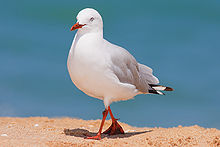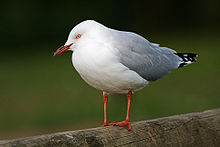- Silver Gull
-
Silver Gull 
Adult Conservation status Scientific classification Kingdom: Animalia Phylum: Chordata Class: Aves Order: Charadriiformes Family: Laridae Genus: Chroicocephalus Species: C. novaehollandiae Binomial name Chroicocephalus novaehollandiae
(Stephens, 1826)Subspecies C. n. forsteri (Mathews, 1912)
C. n. gunni Mathews 1912
C. n. novaehollandiae (Stephens, 1826)Synonyms Larus novaehollandiae
The Silver Gull (Chroicocephalus novaehollandiae) also known simply as "seagull" in Australia, is the most common gull seen in Australia. It has been found throughout the continent, but particularly coastal areas. The South African Hartlaub's Gull (C. hartlaubii) and the New Zealand Red-billed Gull (C. scopulinus) were formerly sometimes considered to be subspecies of the Silver Gull. As is the case with many gulls, it has traditionally been placed in the genus Larus but is now placed in the genus Chroicocephalus.
The Silver Gull should not be confused with the Herring Gull, which is called "silver gull" in many other languages (scientific name Larus argentatus, German Silbermöwe, French Goéland argenté, Dutch zilvermeeuw) but is a much larger, robust gull with no overlap in range.
The Silver Gull has a sharp voice consisting of a variety of calls. "The most common call is a harsh 'kwee-aarr'."[2]
Contents
Description
The head, body and tail are white. The wings are light grey with white spotted, black tips.[3] Adults range from 40–45 cm in length.[3] Mean wing span is 94 cm.[4] Juveniles have brown patterns on their wings, and a dark beak. Adults have bright red beaks—the brighter the red, the older the bird.
Distribution and habitat
Silver gulls are found in all states of Australia.[4] It is a common species, having adapted well to urban environments and thriving around shopping centres and garbage dumps.
Silver Gulls have twice been recorded in the USA; one bird was shot in August 1947 at the mouth of the Genessee River, Lake Ontario and another one was photographed in Salem County, New Jersey, in autumn 1996. Both are nowadays believed to have escaped from captivity (AOU, 2000).
Behaviour
Feeding
The silver gull naturally feeds on worms, fish, insects and crustaceans. It is a successful scavenger, allowing increased numbers near human settlements.
Breeding
Breeding occurs from August to December.[4] The nest is located on the ground and consists of seaweed, roots and plant stems.[4] The nests may be found in low shrubs, rocks and jetties.[4] Typical clutch size is 1–3 eggs.[3][4]
Various views and plumages
-
a silver gull in Circular Quay railway station, Sydney
Off Gold Coast, Australia
References
- ^ BirdLife International (2004). Larus novaehollandiae. 2006. IUCN Red List of Threatened Species. IUCN 2006. www.iucnredlist.org. Retrieved on 11 May 2006. Database entry includes justification for why this species is of least concern
- ^ Silver Gull, Birds in Backyards
- ^ a b c "Silver Gull". Birds in Backyards, Australian Museum. 23-Jan-07. http://www.birdsinbackyards.net/finder/display.cfm?id=95. Retrieved 2009-05-10.
- ^ a b c d e f Pizzey, Graham; Knight, Frank (1997). Field Guide to the Birds of Australia. Sydney, Australia: HarperCollinsPublishers. p. 111. ISBN 0 207 18013 X.
- American Ornithologists' Union (AOU) (2000): Forty-second supplement to the American Ornithologists' Union Check-list of North American Birds. Auk 117(3): 847–858. DOI: 10.1642/0004-8038(2000)117[0847:FSSTTA]2.0.CO;2
- Harrison, Peter (1988): Seabirds (2nd ed.). Christopher Helm, London. ISBN 0-7470-1410-8
- Pons J.M., Hassanin, A., and Crochet P.A.(2005). Phylogenetic relationships within the Laridae (Charadriiformes: Aves) inferred from mitochondrial markers. Molecular phylogenetics and evolution 37(3):686-699
Gulls (family: Laridae) Genus Larus Pacific Gull • Belcher's Gull • Olrog's Gull • Black-tailed Gull • Heermann's Gull • Common Gull (or Mew Gull) • Ring-billed Gull • California Gull • Great Black-backed Gull • Kelp Gull (or Cape Gull) • Glaucous-winged Gull • Western Gull • Yellow-footed Gull • Glaucous Gull • Iceland Gull • Kumlien's Gull • Thayer's Gull • European Herring Gull • Heuglin's Gull • American Herring Gull • Yellow-legged Gull • Caspian Gull • Vega Gull (or East Siberian Gull / Mongolian Gull) • Armenian Gull • Slaty-backed Gull • Lesser Black-backed GullIchthyaetus Leucophaeus Chroicocephalus Saundersilarus Hydrocoloeus Rhodostethia Rissa Pagophila Xema Creagrus Categories:- IUCN Red List least concern species
- Gulls
- Chroicocephalus
- Birds of South Australia
- Birds of Tasmania
- Birds of Western Australia
- Birds of Victoria (Australia)
Wikimedia Foundation. 2010.








